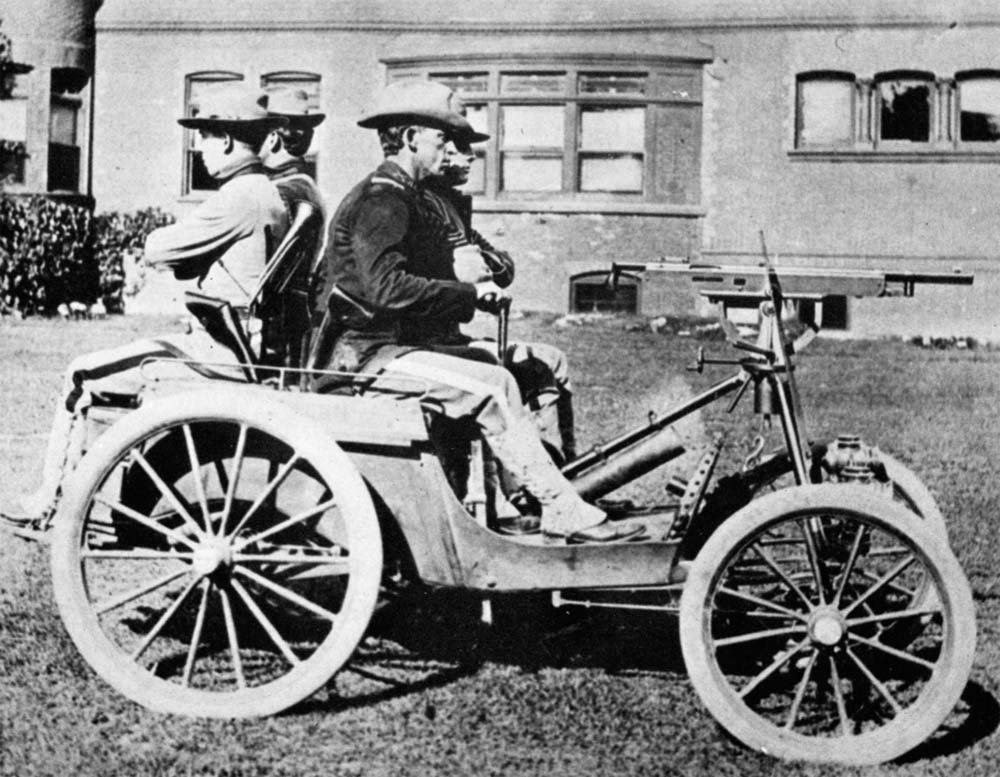
In 1898, Colonel Royal P. Davidson, an officer in the Illinois National Guard, mounted a machine gun protected by an armoured shield on a small Duryea three-wheeled car. This was America’s first wheeled armoured fighting vehicle (AFV), although it never entered into US Army service. He later mounted the same armoured shield protected machine gun on a four-wheel Duryea car.
Davidson went on to progressively develop a series of new armoured cars, based on the chassis of Cadillacs. In 1910, Davidson displayed several partially armoured, machine gun equipped vehicles, and in 1914 he unveiled a fully armoured, machine gun equipped armoured car. Despite Davidson’s best efforts, the US Army showed no interest in his vehicles.
Davidson was not alone in envisioning a future for wheeled AFVs with the American military. In 1915, the US Army tested a vehicle they referred to as ‘Armored Car No. 1’. It was a fully armoured machine gun equipped vehicle based on the chassis of the ‘Jeffery Quad’ truck.
The White Motor Company came up with their own vehicle in 1915, which the US Army labelled ‘Armored Car No. 2’. Like the Jeffery vehicle, it was a based on a four-wheeled truck chassis, completely armoured, and armed with machine guns.
In 1916, the New York National Guard acquired three open-topped armoured cars. Each vehicle built upon a different commercial truck chassis. That same year, the US Army pressed into service all three of the New York National Guard’s new armoured cars, as well as both the Jeffery and White armoured cars, for use during the Mexican Expedition, which lasted from 1916 to 1917.
The US Marine Corps (USMC) acquired a single King Armored Car from the Armored Motor Car Company in 1916, with two more acquired the following year. The King Armored Cars were fully armoured, and armed with a single turret-mounted small-calibre machine gun. They were based on the chassis of a 4 × 2 car designed and built by the King Motor Car Company.
The USMC testing of the three King Armored Cars went well enough that eight more were ordered in 1918, which allowed the forming of the 1st Armored Car Squadron. However, not everybody thought the King Armored Car was worth acquiring. In a 1919 report by a USMC captain named Drum appears this extract:
Found only seven in commission and five of these put through testing. Performance not all that good, as the design is poor and insufficient persons available to keep cars in running order. Only well-trained drivers can operate the cars. The XO [executive officer] of the Armored Car squadron, 2Lt Charles B. Long, is one and can handle it in any terrain reasonably expected. Cars are underpowered, weak transmissions, but could render good service if overhauled. Recommend that of the eight cars at Phil [Philadelphia] six be entirely taken into overhaul, other two have armour removed, use chassis for spares.
Other than taking part in a number of public demonstrations, none of the King Armored Cars would ever see combat. The 1st Armored Car Squadron would be disbanded in 1921, and their vehicles placed into storage. Five King Armored Cars were later pulled out of storage and employed briefly by the USMC during its occupation of Haiti (1915–34). They were returned to storage in 1927 and most were eventually scrapped in 1934. At least two examples of an improved model would be tested by the US Army in the 1920s, with no orders resulting.
Before the various combatants had settled into the trench warfare that has come to define the First World War, the British, French, and Belgians had employed improvised armoured cars, based on commercial vehicles, for reconnaissance duties, as well as other roles such as raiding enemy lines and airfield defence.
Despite America’s official entry into the First World War in 1917, there were no calls by the US Army for armoured cars at that time. Those in charge felt that the trench fighting being conducted in France did not lend itself to their employment. The USMC had offered to deploy an infantry division to France, along with the 1st Armored Car Squadron, but this offer was rejected by the senior US Army General in that theatre of operation.
During the last few months of the First World War, the Service of Supply organization in France, which was overseen by the US Army Quartermaster Corps, requested armoured cars for the protection of the interior line of communications in that country. However, nothing ever came of the request before ‘The War to End all Wars’ concluded.
From the mid-1920s up through the early 1930s, the US Army Quartermaster Corps explored the possibility of using off-the-shelf commercial truck components to develop a series of 4 × 4 vehicles. These vehicles were intended for use as cargo trucks or converted into improvised armoured cars if the need arose.
The first improvised Quartermaster Corps armoured car was labelled the T6-4WD. It featured a machine gun armed turret. The code letter designation ‘T’ stood for test in the US Army nomenclature system, starting post-First World War. The ‘4WD’ in the vehicle’s designation code stood for four-wheel drive. After the construction of the T6, the Quartermaster Corps no longer used the 4WD designation.
The single T6-4WD Armored Car was followed by six units of the improvised T7 Armored Car. Because the T7 was powered by a Franklin Automotive Company car engine, it was sometimes referred to as the ‘Franklin Armored Car’.
The Quartermaster Corps also looked at the possibility of using the chassis of various 4 × 2 commercial cars as the basis for improvised armoured cars. This resulted in a number of experimental vehicles labelled the T8, T9 and T10. There was also a small 4 × 2 armoured car submitted by American inventor J. Walter Christie, named the M1933 Airborne Combat Car. None of these experimental armoured cars were ordered into series production by the US Army.
In a duplication of effort, the US Army Ordnance Department also explored using the chassis of various 4 × 2 commercial cars as the basis for improvised armoured cars. Like those tested by the Quartermaster Corps, those tested by the Ordnance Department were only partially armoured. The first was the T1 Armored Car, followed by the progressively-improved T2 and T3 Armored Cars.
In 1932, the US Army decided that the T3 would no longer be considered an armoured car, but thereafter be known as the T1 Scout Car. The US Army eventually concluded that scout cars, based on 4 × 2 civilian cars, lacked the necessary off-road capabilities and load-carrying capacity, which ended any further development.
The US Army decided in 1931 to go forward with its first ground-up design for an armoured car, that was originally designated as the T4. It was a 6 × 4 vehicle with front wheels being employed only for steering. The T4 was fully armoured and came with a machine gun equipped turret.
The US Army concluded that the testing process with the T4 went well and, in 1934, standardized the vehicle as the M1 Armored Car, with twenty units ordered. Due to the small number ordered the government-owned and government-operated Rock Island Arsenal was assigned the task of building the vehicles.
American military vehicles receive an ‘M number’ when standardized (approved for series production). The M number and the assigned number/numbers (which represents an acquisition sequence) also mean a vehicle was developed and acquired, or modified and acquired through a Program of Record (POR) by the US Army. The US Army has been responsible for the development and fielding of the majority of land combat systems employed by the American military.
An unsuccessful rival to the M1 Armored Car was the rear-engine powered T11 Armored Car, which was also fully armoured, and fitted with a machine gun equipped turret. A more capable vehicle than the M1, the 4 × 4 T11 had some unresolved design issues.
Not wanting to give up on the T11 Armored Car, the Ordnance Department awarded the Marmon-Herrington Company a contract to build six improved units, labelled the T11E1, for additional testing. There was also a single revised example of the vehicle, designated the T11E2. None met US Army expectations.
The code letter ‘E’ in a vehicle’s designation meant the original design was modified in some way. The number following the letter ‘E’ stood for the sequence number of the modification. Hence, you have the T11E1 followed by the T11E2. This designation system also applied to vehicles assigned an M number.
The first of the new second-generation open-top machine gun armed scout cars was initially designated as the T7 and tested by the US Army in 1934. Upon meeting all the service’s expectations, the vehicle was standardized as the M1 Scout Car. Unlike the M1 and T11 Armored Cars, the 4 × 4 M1 Scout Car was an improvised wheeled AFV, based on a commercial chassis frame.
Seventy-six units of the M1 Scout Car were ordered from the designer, the Indiana Motor Corporation, a subsidiary of the White Motor Company. All were delivered between 1934 and 1937.
In 1937, the US Army decided to do away with the term ‘armored car’. Instead, all wheeled AFVs would hereafter be referred to as ‘scout cars’. This naming policy would be in effect until mid-1941, when the term armored car came back into favour. It was used to describe fully armored wheeled vehicles fitted with weapon-armed turrets. Open-top machine-gun equipped wheeled armored vehicles would continue to be referred to as scout cars.
At the same time, the US Army was testing the T7 Scout Car. They also briefly evaluated a Marmon-Herrington Company Scout Car design. The US Army felt it had some commendable design features that were superior to the White Motor Company offering, but never pursued it. Nor did it bother to assign it an official service designation. There was also a T8, T10 and T11 Scout Car being considered at one point in time, but they never left the drawing board.
On the heels of the acceptance of the M1 Scout Car, the US Army could see the value of adding some design improvements. This resulted in the testing in 1935 of another very similar-looking open-top, machine gun armed vehicle, labelled the T9 Scout Car. The US Army liked what it saw with the 4 × 4 T9 Scout Car and standardized it in 1938 as the M2 Scout Car. The US Army took into its inventory a total of twenty units of the M2 Scout Car in 1938. There were also two upgraded examples of the vehicle built for test purposes, designated the M2E1, which did not enter into production.
Continuous design upgrades to the M2 Scout Car led to an improved model being built that was originally designated M2A1 Scout Car. This was later changed to the M3 Scout Car. The US Army assigned the production of the vehicle to the White Motor Company.
The letter ‘A’ added to a vehicle’s designation code meant it underwent a minor design modification, with the number following the letter ‘A’ denoting its sequence of production. A major design modification would typically be reflected in the vehicle’s designation code by the application of a higher number. This is reflected in the M2A1 Scout Car eventually being relabelled as the M3 Scout Car.
In 1940, White began production of a redesigned model of the M3 Scout Car, which was assigned the designation M3A1 Scout Car. Between 1939 and 1944, the firm would construct 20,894 units of the M3A1 Scout Car. Like the M2, M2A1 and M3, the Diebold Lock & Safe Company provided the armoured bodies for the M3A1 Scout Car.
The USMC ordered hundreds of M3A1 Scout Cars in early 1942. However, once the Corps’ attention turned to the difficulties of invading enemy-occupied islands in the Pacific, it was decided that the much smaller and lighter four-wheel drive 0.25-ton truck, better known as the ‘Jeep’, would be a better choice and the order for the M3A1s was cancelled.
During combat against Axis Forces in the US Army’s North African Campaign (November 1942 until May 1943), the M3A1 Scout Car was assigned to US Army armoured reconnaissance battalions. Its lacklustre off-road performance and lack of overhead armour protection made it unpopular, and it was quickly replaced when something better came along.
A reflection of the US Army’s lack of confidence in the M3A1 Scout Car can be deduced by the 11,401 units of the vehicle allocated to Lend-Lease, which was in effect from March 1941 until the end of the Second World War. Of that number, 6,987 went to the British Army, 3,310 to the Red Army and 104 to the Nationalist Chinese Army.
In 1941, prior to America’s official entry into the Second World War, the Smart Engineering Company presented the US Army with a 4 × 4 armoured jeep for consideration, which the service designated as the T25 Scout Car. Despite numerous variants of the T25 series being developed and tested, it was a failure due to the adverse handling characteristics imposed on the vehicle by the addition of armour and weapons it was never designed to carry.
Another armoured scout car submitted to the US Army for consideration in 1941 was an open-top 4 × 4 vehicle designed and built by the Ford Motor Company. It was assigned the strange designation Observation Post Vehicle T2. It was never ordered into production.
A pre-Pearl Harbor armoured car submitted to the US Army for consideration was a large eight-wheel 8 × 8 vehicle. It was fully armoured, and had a small open-top weaponless turret. It was designed and built by the Trackless Tank Corporation.
Initially impressed by the off-road capabilities of the Trackless Tank Corporation’s product, the US Army anticipated ordering it in several different versions for more intense testing. These would include a T13 Armored Car armed with a 37mm cannon, another armed with a 3-inch gun designated the T7 Tank Destroyer and a third mounting a 105mm howitzer to be referred to as the T39 Self-Propelled Howitzer.
Because the Trackless Tank Corporation lacked the industrial infrastructure to build the large numbers of vehicles the US Army was envisioning, the service demanded that it contract with a much larger firm, in this case Reo Motors, which had the capability to build a large number of vehicles if a contract was awarded.
Due to a series of unforeseen delays, the first two modified examples of the T13 Armored Car built by Reo Motors were not ready for testing by the US Army until the summer of 1942. Upon further testing, a number of serious design flaws cropped up and the entire programme was soon cancelled.
The National Defense Research Committee, which was in existence between 1940 and 1941, also attempted to develop a suitable series of wheeled armoured fighting vehicles for US Army consideration. They envisioned a 4 × 4 or 8 × 8 AFV equipped with a hydraulically-operated jumping apparatus. It was intended that the jumping apparatus would allow it to leap over intervening obstacles when moving at high speed. This particular vehicle concept never went past the model stage.

At the very end of the nineteenth century, Colonel Royal P. Davidson of the Illinois National Guard demonstrated a modified three-wheel commercial car fitted with an armoured shield-protected small-calibre machine gun. Shortly thereafter, he modified the same vehicle to have four wheels as seen here. Colonel Davidson is at the controls of the vehicle. (Patton Museum)
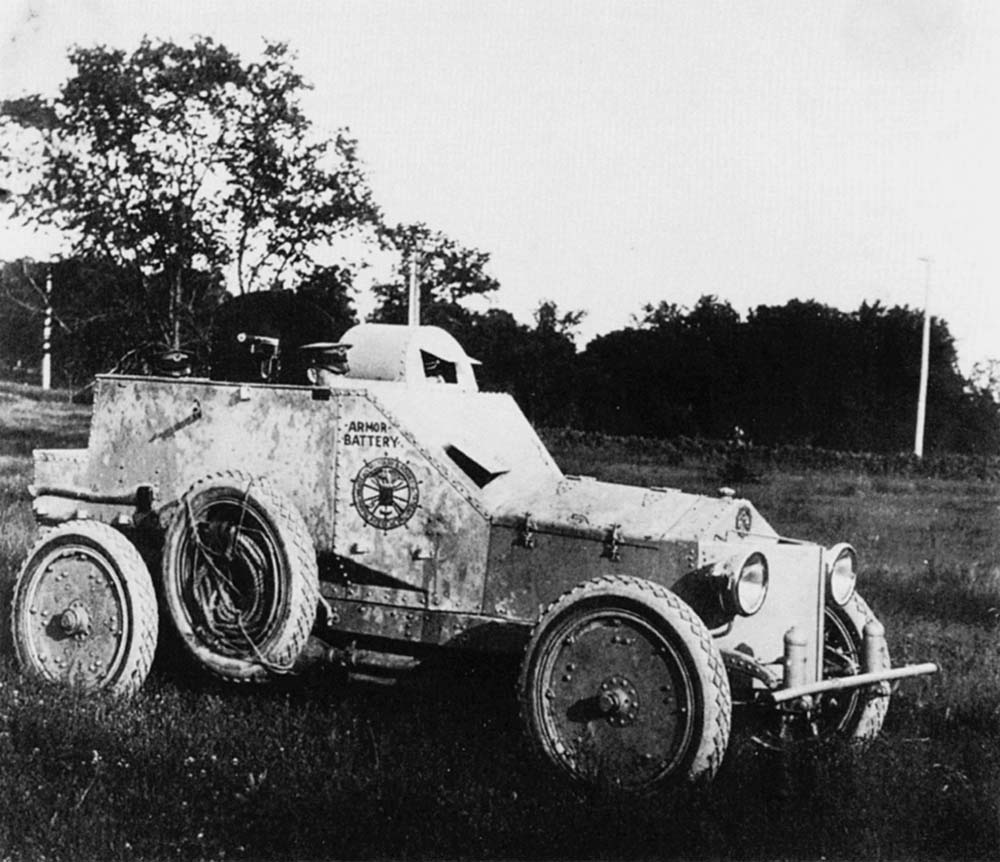
Colonel Davidson continued to experiment with the development of wheeled armoured fighting vehicles (AFVs) prior to America becoming a participant in the First World War. Pictured is one of his later prototypes, now fully armoured, and based on the chassis of a Cadillac. The driver is protected by a small overhead armoured housing. (Patton Museum)
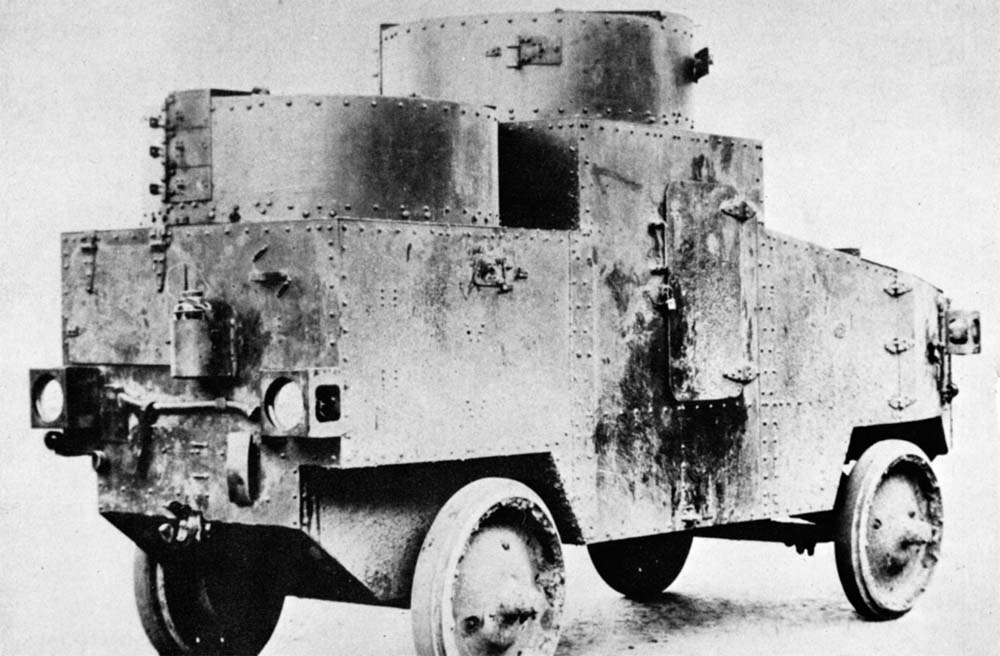
Other individuals and companies were also experimenting with the concept of fully armoured wheeled AFVs. Shown is a rear view of a single prototype vehicle built by the Jeffrey Motor Company the US Army labelled Armored Car No. 1. A novel design feature that appeared with this vehicle was having a driver in both the front and rear of the vehicle. (Patton Museum)
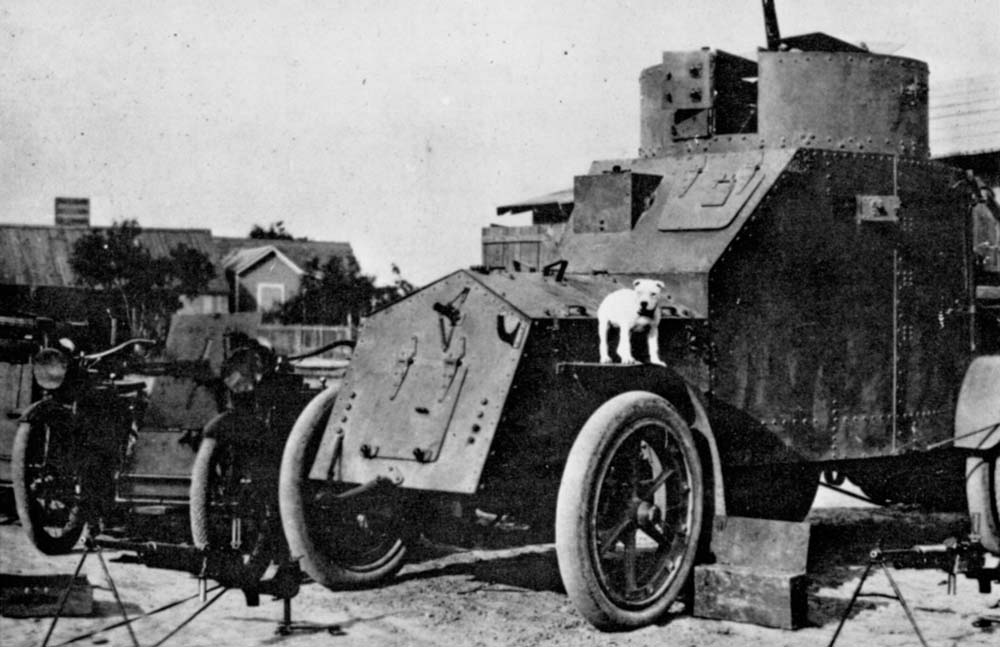
Pictured is the White Motor Company prototype vehicle labelled Armored Car No. 2 by the US Army. Like the Jeffery Armored Car No. 1, it was pressed into service by the US Army to patrol the American-Mexican border in 1916 and 1917. Pictured to the left of the armoured car are two motorcycles with sidecars fitted with shield-protected small-calibre machine guns. (Patton Museum)
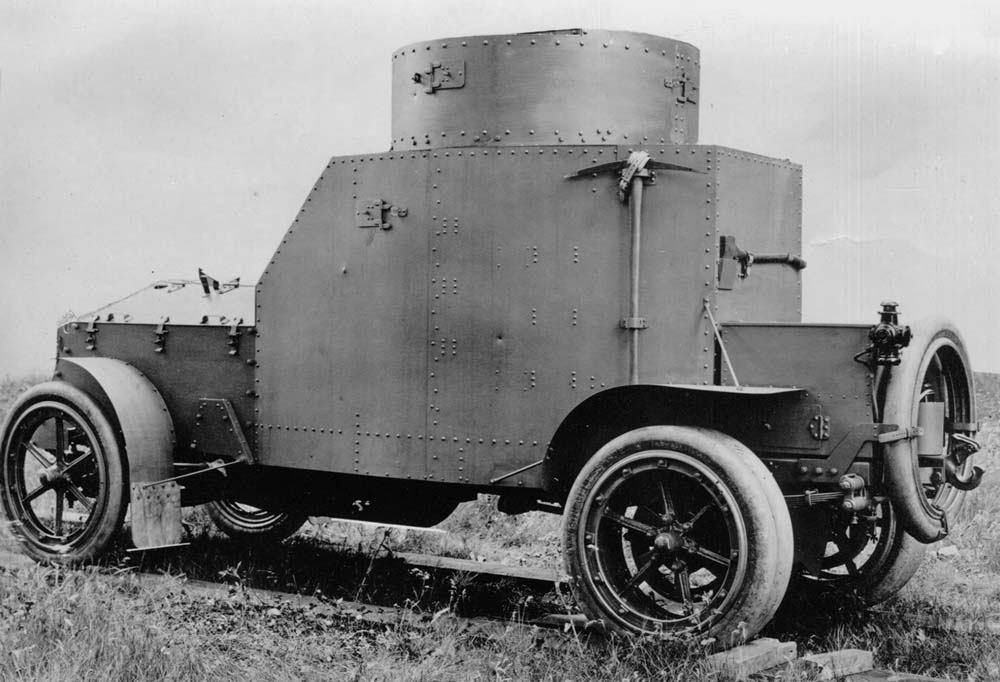
The White Motor Company Armored Car No. 2 rode on large solid rubber wheels as seen here. As with the Jeffery Armored Car No. 1, the vehicle was obviously top-heavy and its off-road ability was no doubt minimal at best as only its rear wheels were driven. It is stated that the vehicle’s 36hp engine could propel it to a maximum speed of 40mph on roads. (Patton Museum)
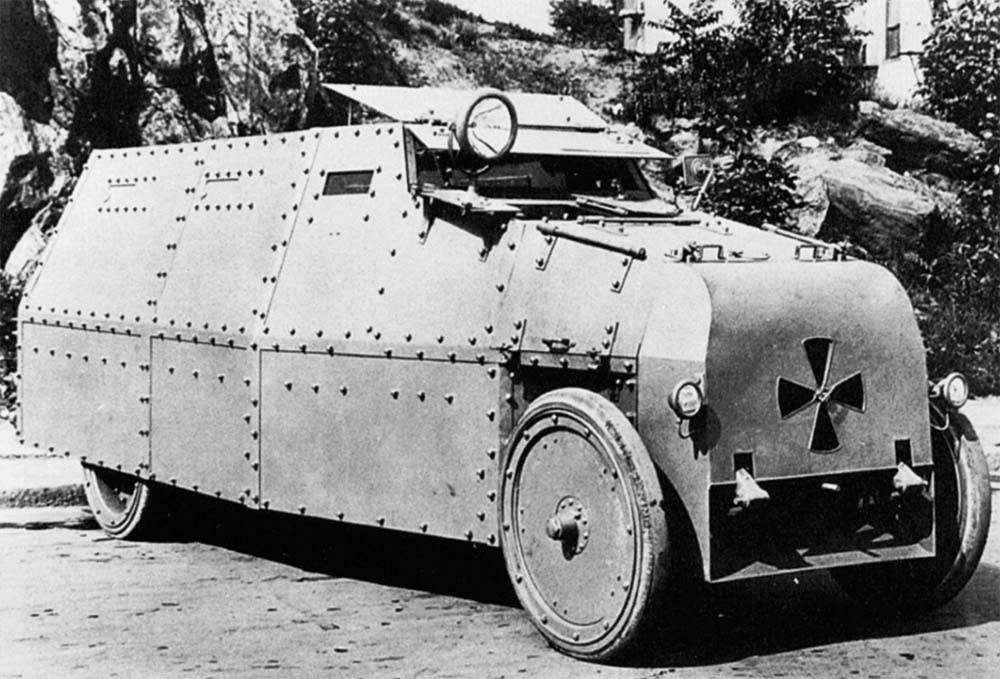
In 1916, the New York National Guard was the recipient of three very similar-looking open-topped armoured cars, paid for with private funds. Each of the three armoured cars was built upon a different truck manufacturer’s chassis. Pictured is the Mack Brothers’ Company version in 1916. It would have been armed with shield-protected small-calibre machine guns. (Patton Museum)
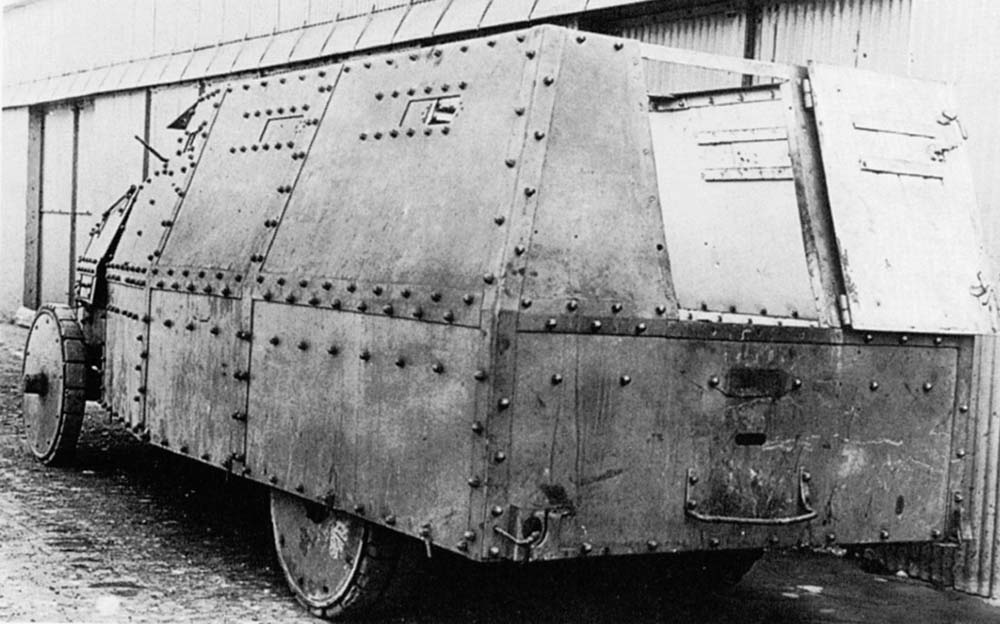
Pictured in 1920 is this rear view of the Mack Brother’s Company version of the three very similar-looking armoured cars purchased for the New York National Guard in 1916 by private donors. The vehicles weighed approximately 9,000lbs and had a top speed of 30mph. They were 17 feet 8 inches long and 5 feet 5 inches tall. (Patton Museum)
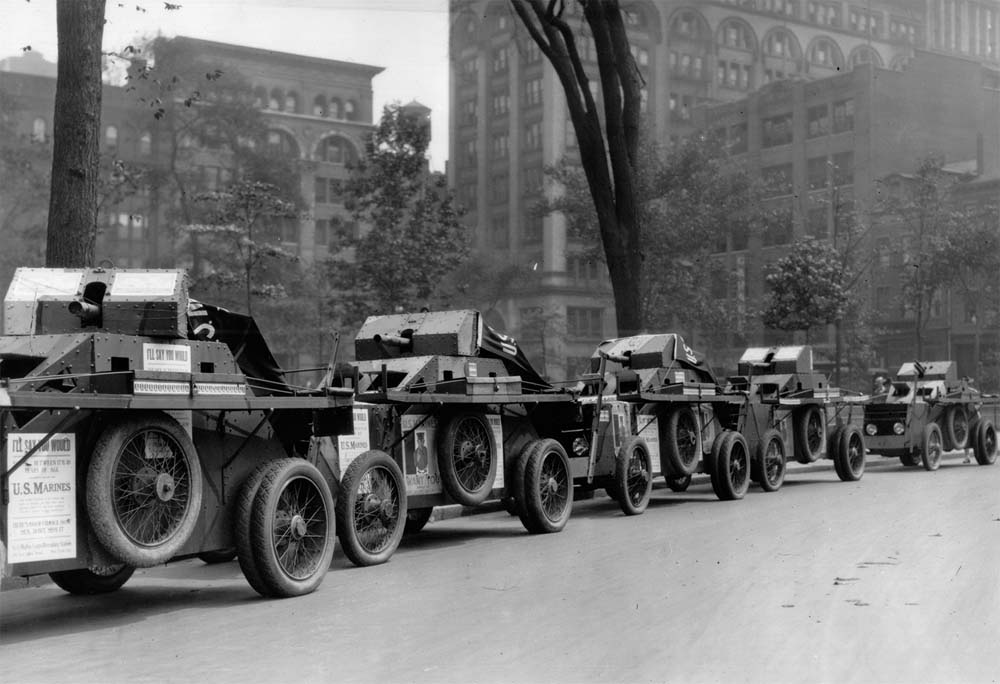
A good part of the USMC inventory of King Armored Cars is seen here at a recruiting drive in New York City in 1919. The vehicle had a crew of three, weighted 5,500lbs and was protected by a quarter inch of armour. Power came from a 70hp engine that provided it a maximum speed of 45mph on roads. Visible are the barrels of the small-calibre machine guns they were armed with. (Patton Museum)
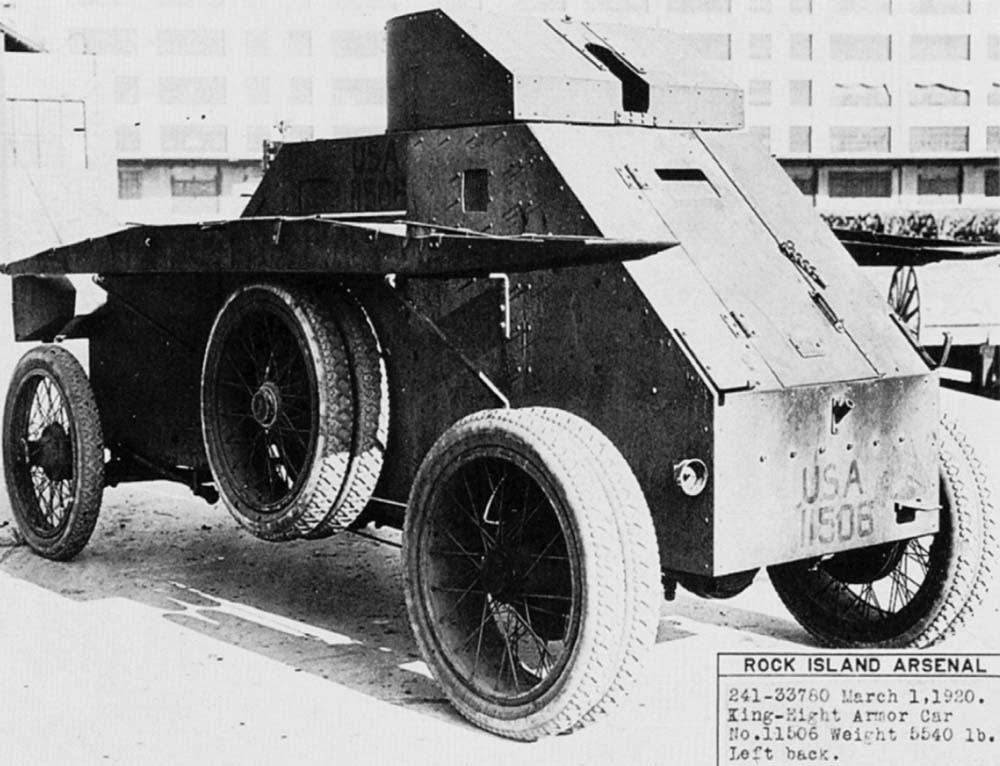
Post-First World War there appeared a version of the King Armored Car, listed as seen in the picture’s caption as the ‘King Eight’. There is little information on this version of the vehicle, which bears US Army markings. Unlike earlier armoured car designs that were fitted with solid rubber tyres, the White Armored Car series rode on pneumatic (air-filled) tyres. (Patton Museum)
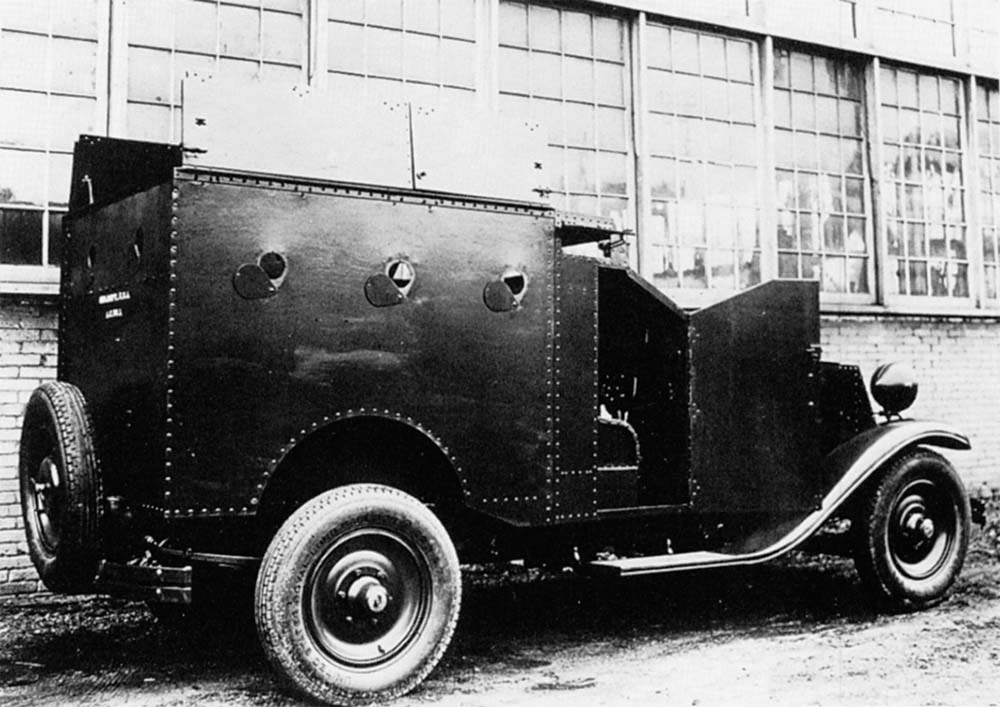
The Medium Armored Car T2, one of four ordered by the US Army in the late 1920s. All were based on the chassis of the LaSalle luxury car from the General Motors Corporation (GMC). The vehicle was protected by steel armour plate 0.125-inch thick and powered by an 86hp engine that gave it a maximum speed of 70mph. Notice the armoured roof panels in the upright position. (Patton Museum)
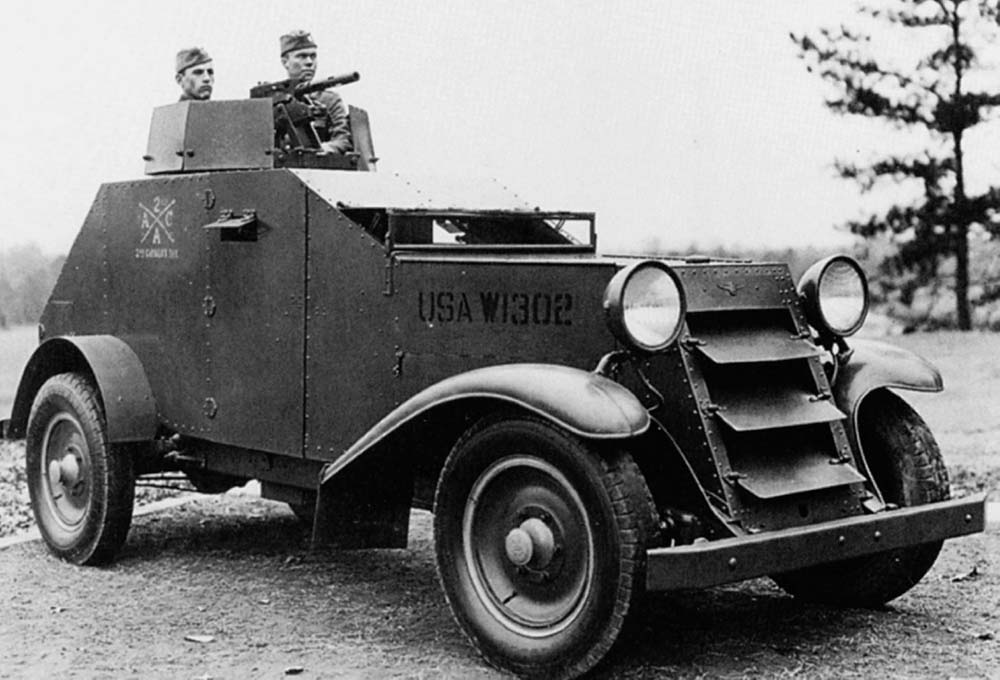
The US Army never stopped tinkering with the design of its four Medium Armored Car T2s to find the optimum configuration. This resulted in four additional versions of the vehicle series, labelled the T2E1 to T2E4. Pictured is the T2E1 Medium Armored Car. It and the three follow-on models were all fitted with a small one-man open-topped turret fitted with a small-calibre machine gun. (Patton Museum)
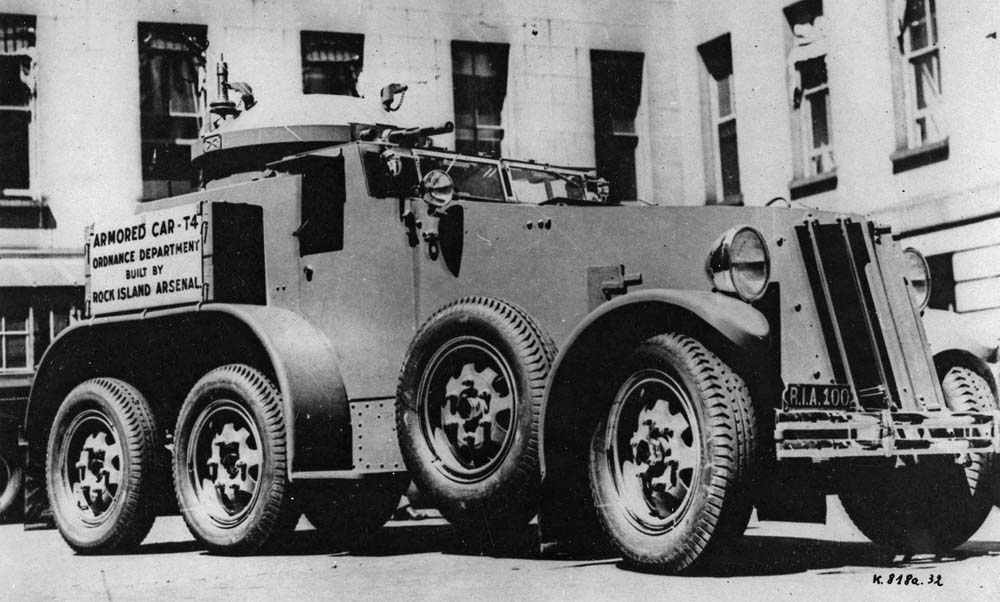
The first American wheeled AFV not based on an existing car or truck chassis was the US Army Armored Car M1 seen here. Unlike the open-topped turrets of previous American wheeled AFVs, the turret of the M1 Armored Car was fully enclosed. It was fitted with a single large-calibre machine gun. There were also two small-calibre machine guns carried in the vehicle. (Patton Museum)
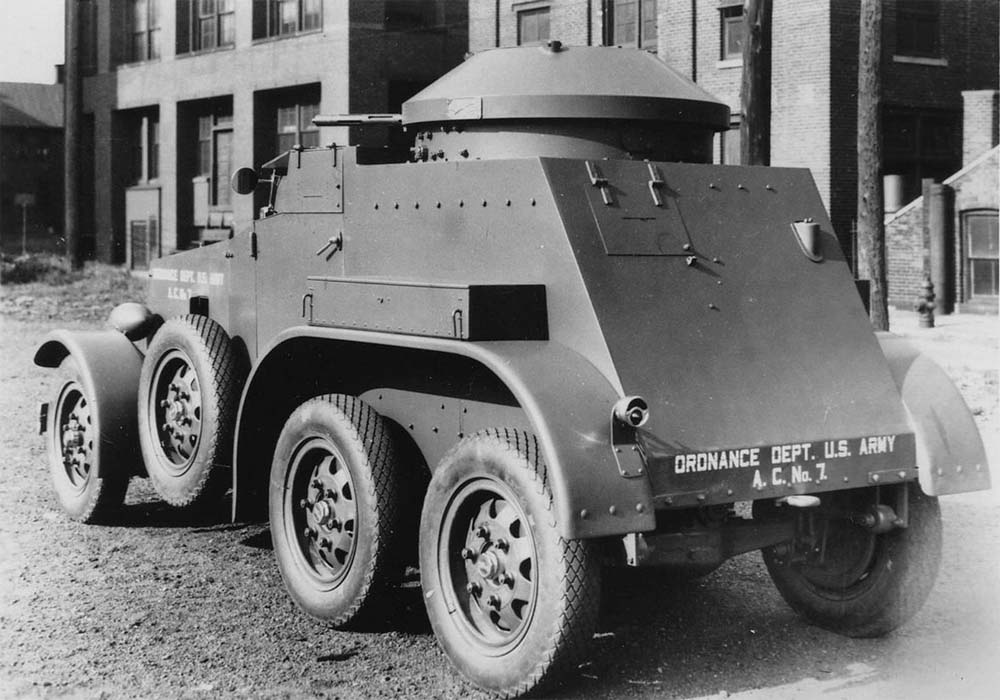
The four-man US Army Armored Car M1 weighed over 10,000lbs, with its maximum armour thickness being 0.5-inch. It was powered by a 133hp engine that gave it a top road speed of 55mph. Unlike subsequent American wheeled AFVs, only the rear wheels were driven on the M1 Armored Car. The non-powered front wheels were employed only for steering the vehicle. (Patton Museum)
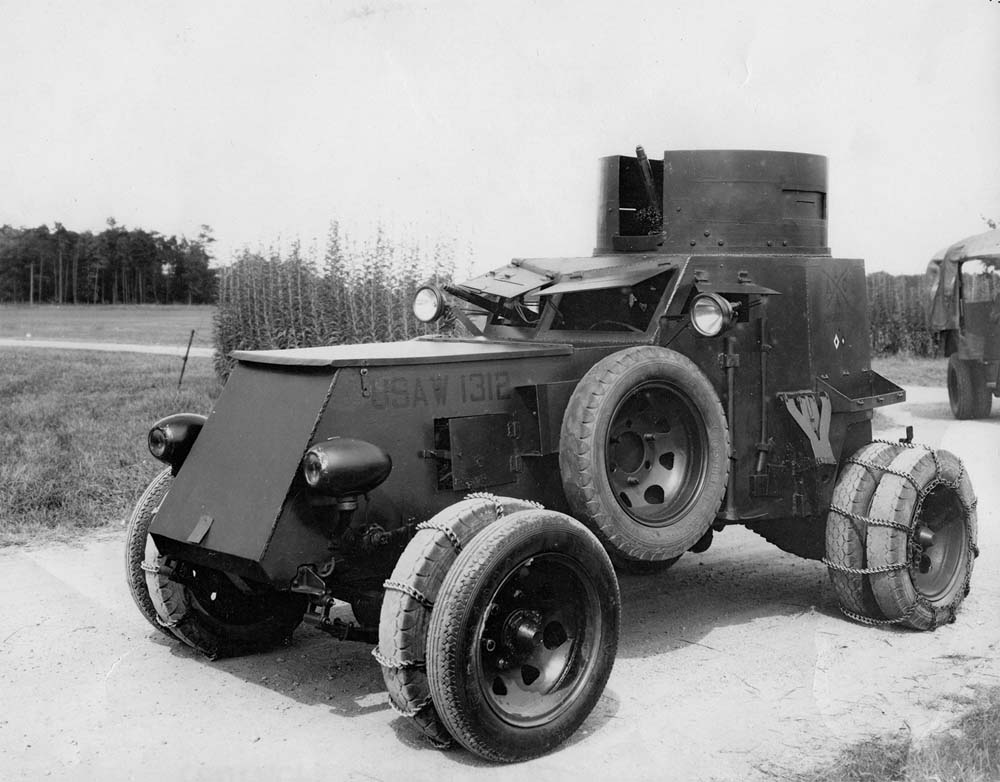
The T7 Armored Car pictured was based on a standard US Army 1.25-ton cargo truck used by the Quartermaster Corps during the interwar period. Like the M1 Armored Car, the T7 had a fully enclosed turret armed with a large-calibre machine gun. In addition, it had two small-calibre machine guns; one mounted to fire out the front of the hull and another out the rear of the hull. (Patton Museum)
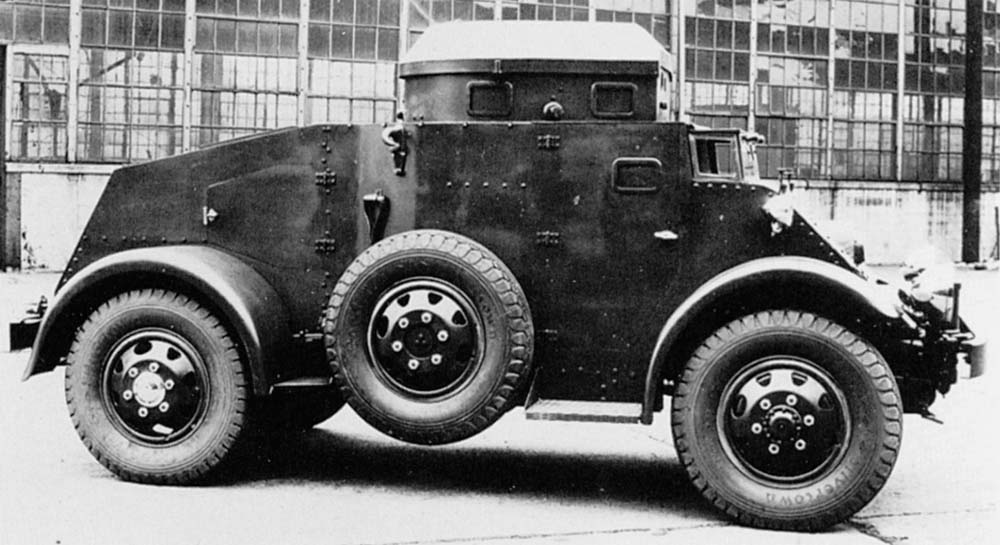
An unsuccessful competitor to the M1 Armored Car was the T11 Armored Car, which weighed 11,250lbs and was protected by armour up to 0.375-inch thick. Design problems with the T11 uncovered during early testing quickly resulted in it being modified into the T11E1 model show here. Power for the vehicle came from a 115hp engine that gave it a maximum road speed of 70mph. (Patton Museum)
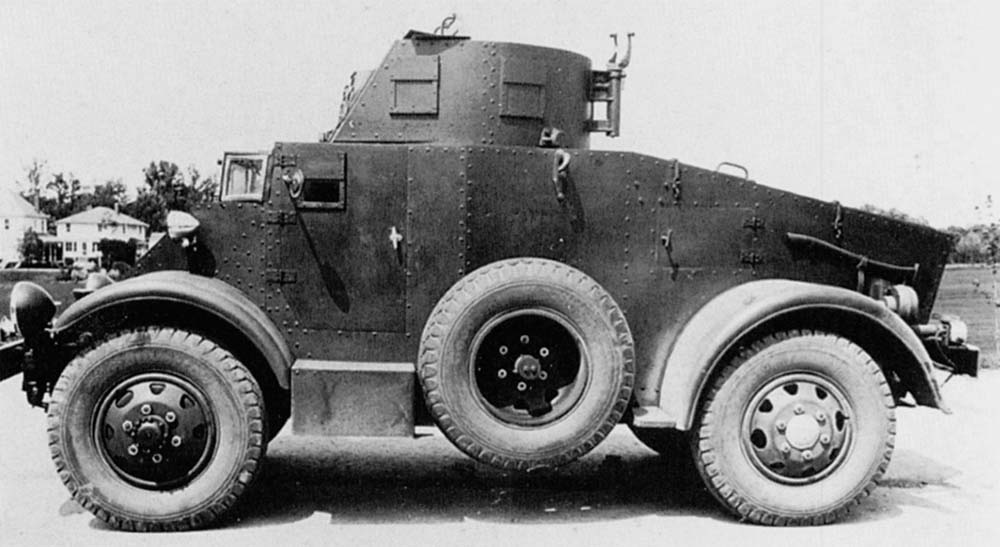
The US Army continued to tweak the design of the T11 series Armored Car, which resulted in the single example of the T11E2 Armored Car shown here. Notice the changes to the hull layout and the new turret design. As with other US Army armoured cars of that time, the wheels positioned on either side of the hull were free-spinning and intended to prevent the vehicle from becoming stuck on uneven terrain. (Patton Museum)
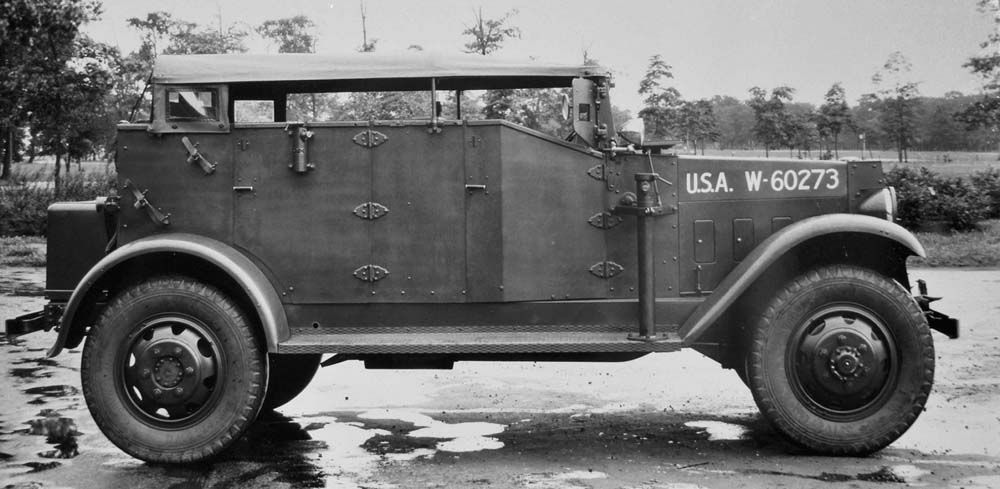
The open-topped Scout Car T7 constructed in 1934. It was based on the chassis of a 0.5-ton 4 × 4 commercial truck from the White Motor Company. The vehicle weighed 7,700lbs and was powered by a 75hp engine. The maximum armour thickness found on the front of the vehicle was 0.5 inch. Testing went well and it was standardized as the Scout Car M1 in 1934 by the US Army. (Patton Museum)
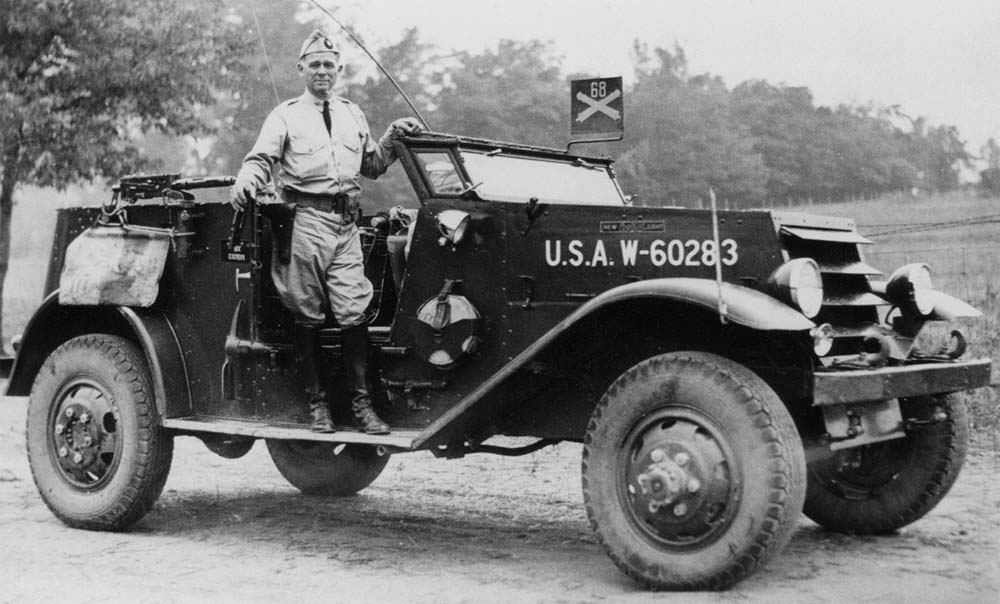
Based on experience gained with the Scout Car M1, the US Army continued with development of the concept, which resulted in the construction of the Scout Car T9. Service tests were successful and the vehicle was standardized as the Scout Car M2, seen here in 1938. It weighed 7,900lbs, and with a 94hp engine had a maximum road speed of 50mph. (Patton Museum)

The continuous refinement of the Scout Car M2 led to an improved model designated as the Scout Car M2A1, which was later changed to the Scout Car M3 seen here. It was produced by the White Motor Company and weighed 16,000lbs. Powered by a 95hp engine, it had a top road speed of 60mph. Maximum armour thickness was 0.5-inch on the front of the vehicle. (Patton Museum)
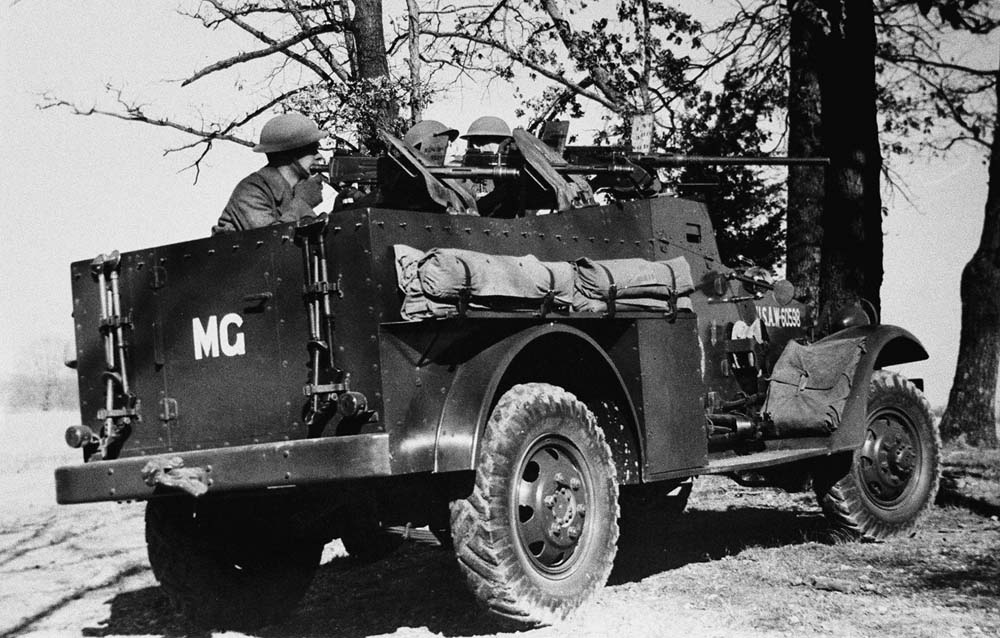
Another view of the Scout Car M3 taking part in a pre-Second World War training exercise. The weapon mix on the vehicle consisted of a single unprotected large-calibre machine gun and two shield-protected small-calibre machine guns, as appears in this photograph. Notice the vehicle has a rear door. (Patton Museum)
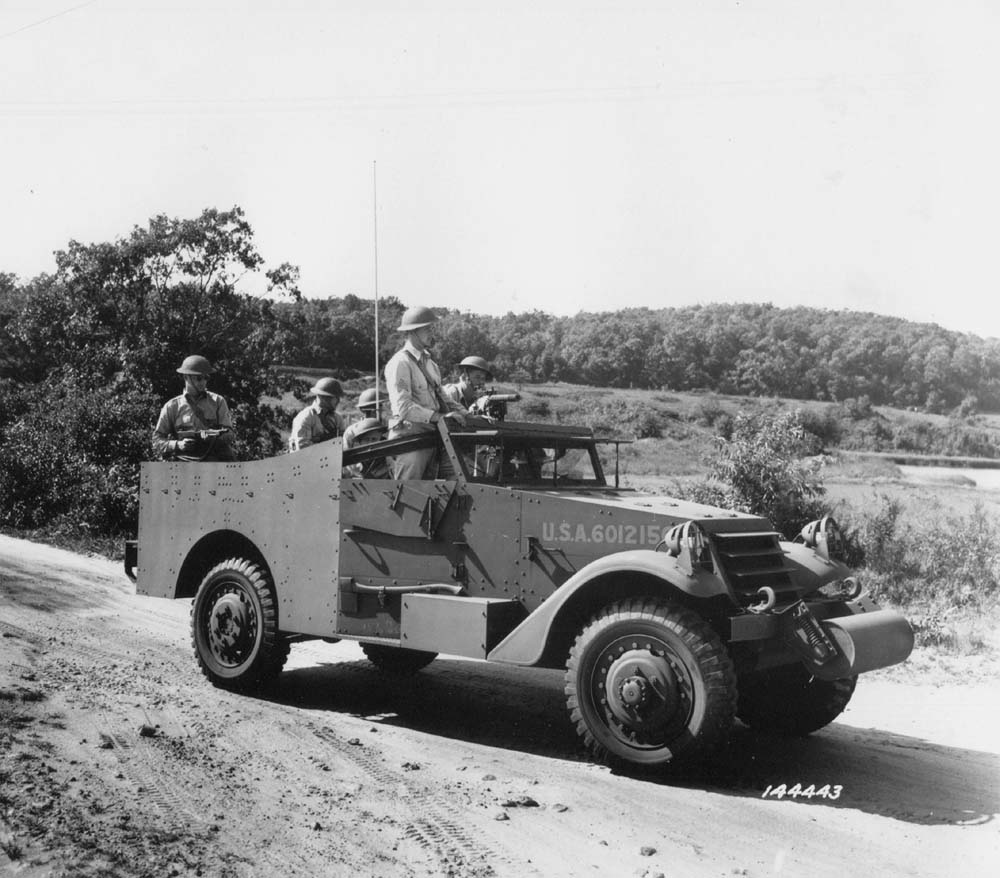
By 1939, a host of design improvements to the Scout Car M3 resulted in a re-designed version being labelled as the M3A1 Scout Car, an example of which is seen here during a pre-Pearl Harbor training exercise within the United States. The front bumper of the M3 Scout Car was replaced with a spring-loaded roller on the M3A1 Scout Car, which is visible in this image. (Patton Museum)
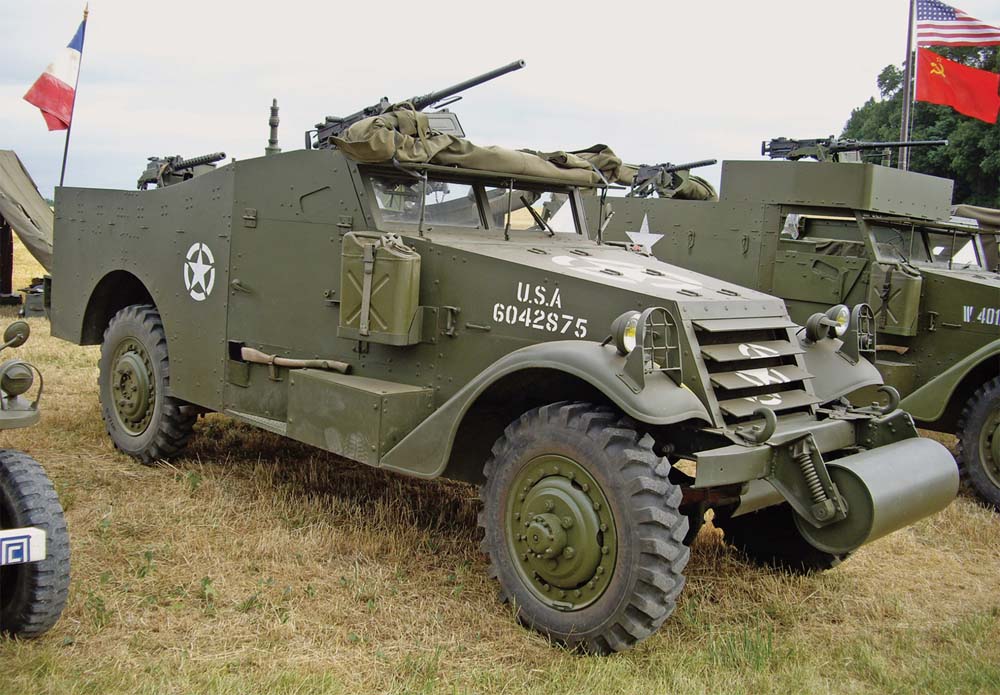
One of the key external differences between the M3 and M3A1 Scout Cars was the widening of the body of the latter over the fender wells, as seen in this photograph of a restored example. The M3A1 Scout Car was 18 feet 5 inches in length and had a width of 6 feet 8 inches. It was 6 feet 6.5 inches tall and combat loaded weighed 12,400lbs. (Pierre-Olivier Buan)
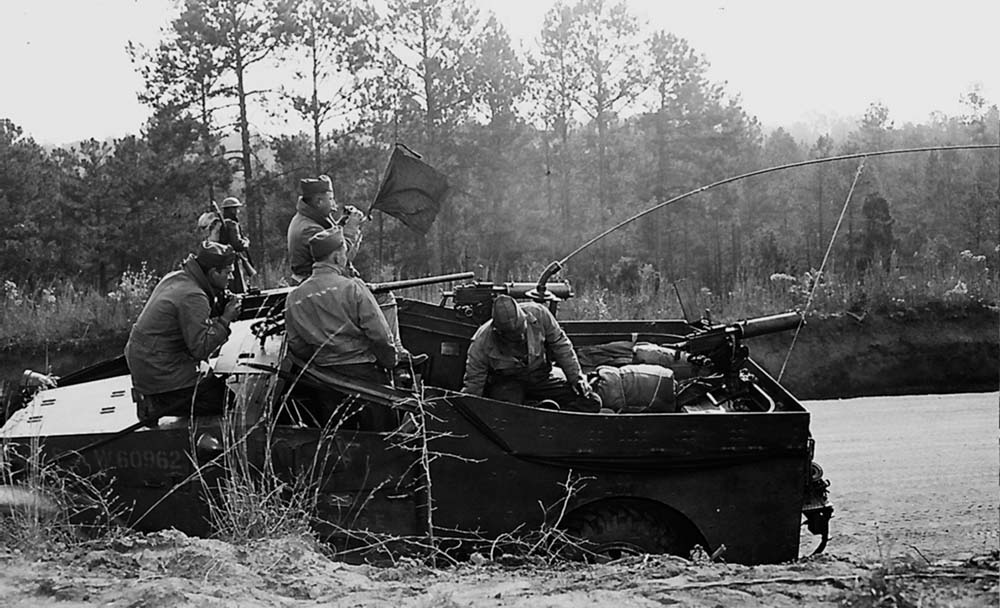
Taking part in a training exercise in the United States pre-Pearl Harbor is this US Army M3A1 Scout Car. As with the M3 Scout Car, it was armed with three machine guns; a single large-calibre machine gun and two small-calibre machine guns. Unlike the air-cooled shield-protected small-calibre machine guns on the M3 Scout Car, those on the M3A1 Scout Car pictured are water-cooled and lack an armoured shield. (Patton Museum)
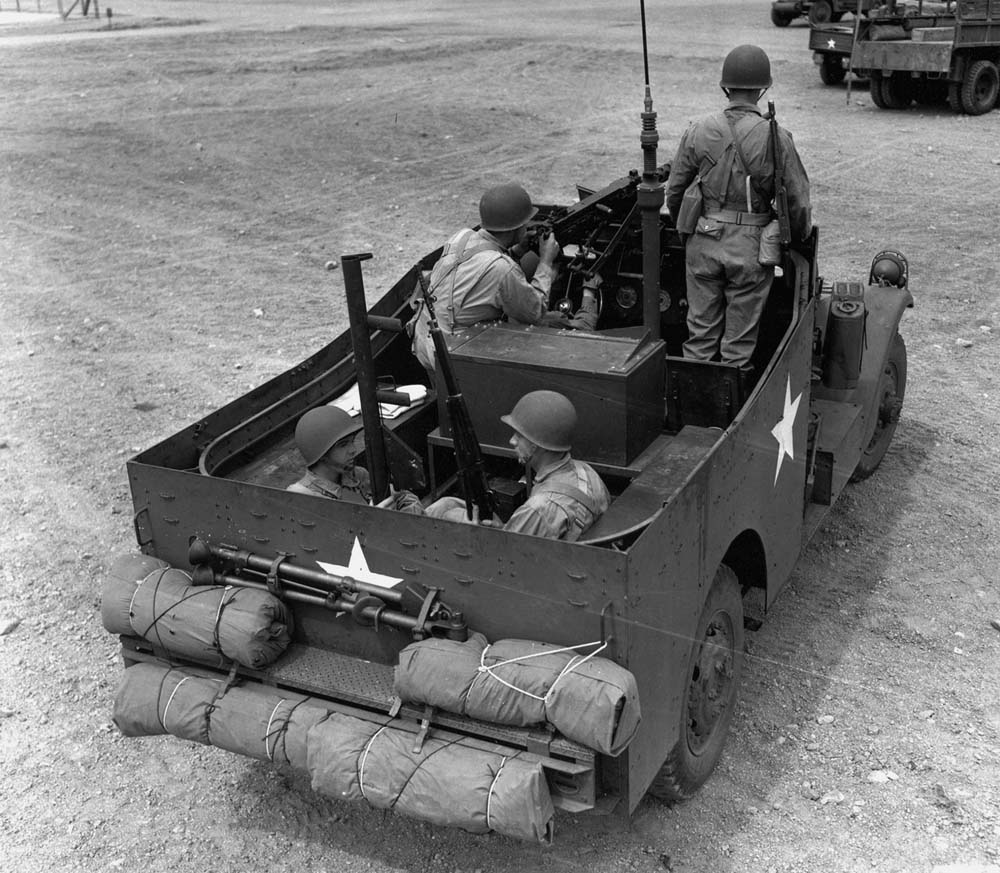
In this picture of a radio-equipped US Army M3A1 Scout Car we can see that the rear door from the M3 Scout Car was dispensed with. Visible is the skate rail upon which the pintle-mounted machine guns of the vehicle were moved about. Due to the size of the radio mounted in the vehicle pictured, the two small-calibre machine guns normally fitted are not present. (Patton Museum)
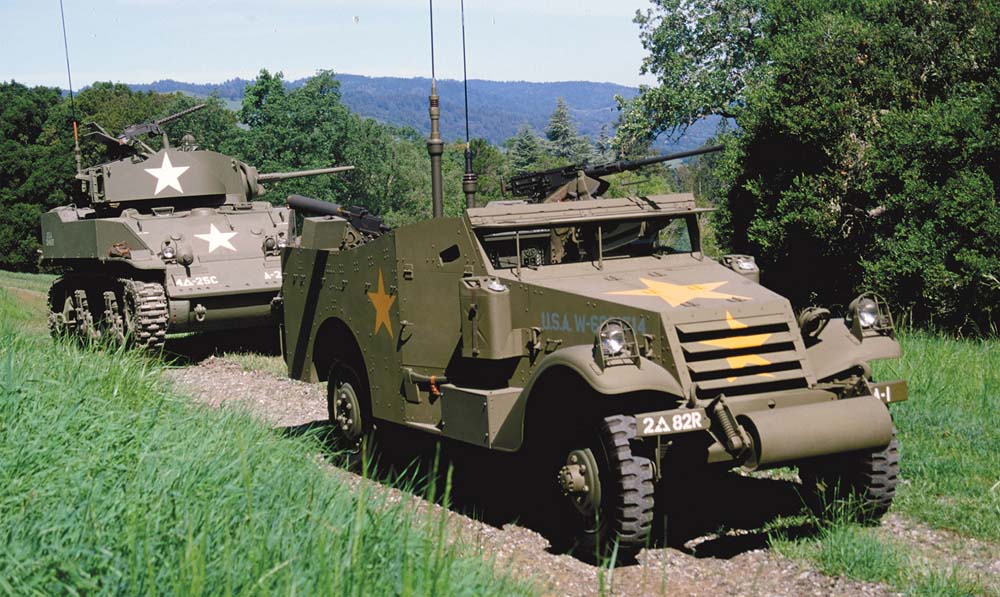
A restored M3A1 Scout Car and M5A1 Light Tank. The M3A1 was powered by an 87hp engine that provided it a maximum speed on level roads of 50mph. It was able to cross a trench 1.5 feet wide, and climb over a vertical wall a foot high. Maximum fording depth of the M3A1 Scout Car was 28 inches. (Michael Green)
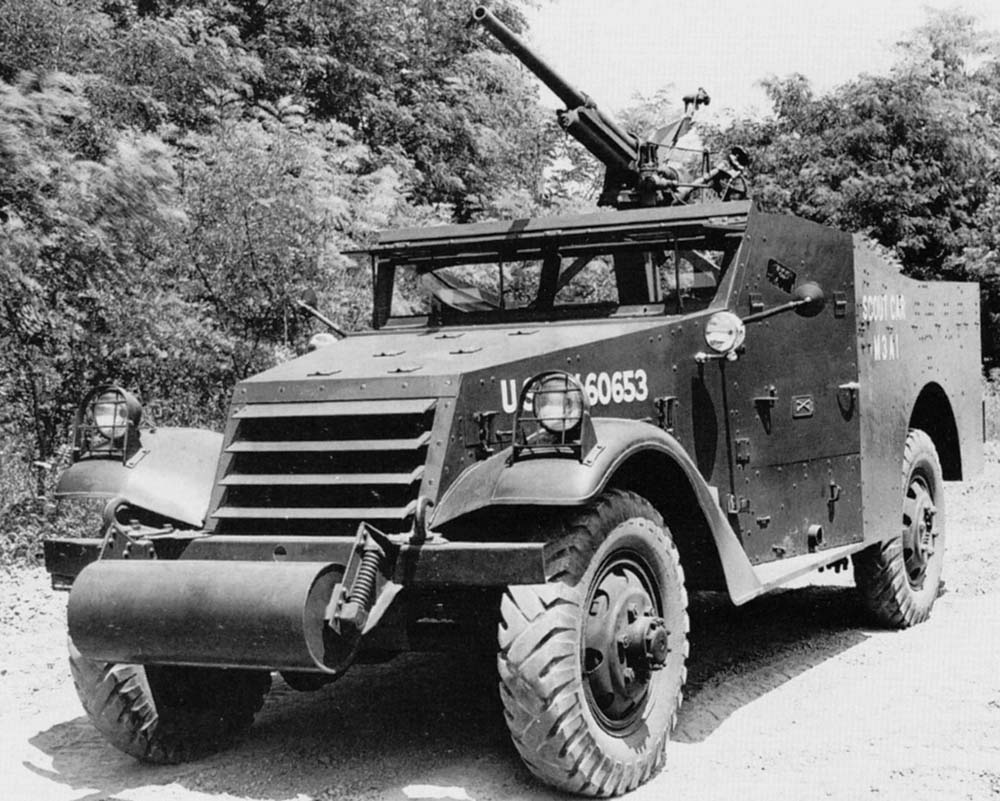
The US Army continued to tinker with the design of the M3A1 Scout Car throughout its service career to improve its performance, and to see if it might be suitable for other roles. One of those proposed roles involved mounting a 37mm anti-tank gun on the vehicle, as seen in this picture. In this configuration it was designated the M3A1E3. However, testing proved the concept was not viable and the experiment was cancelled. (TACOM)
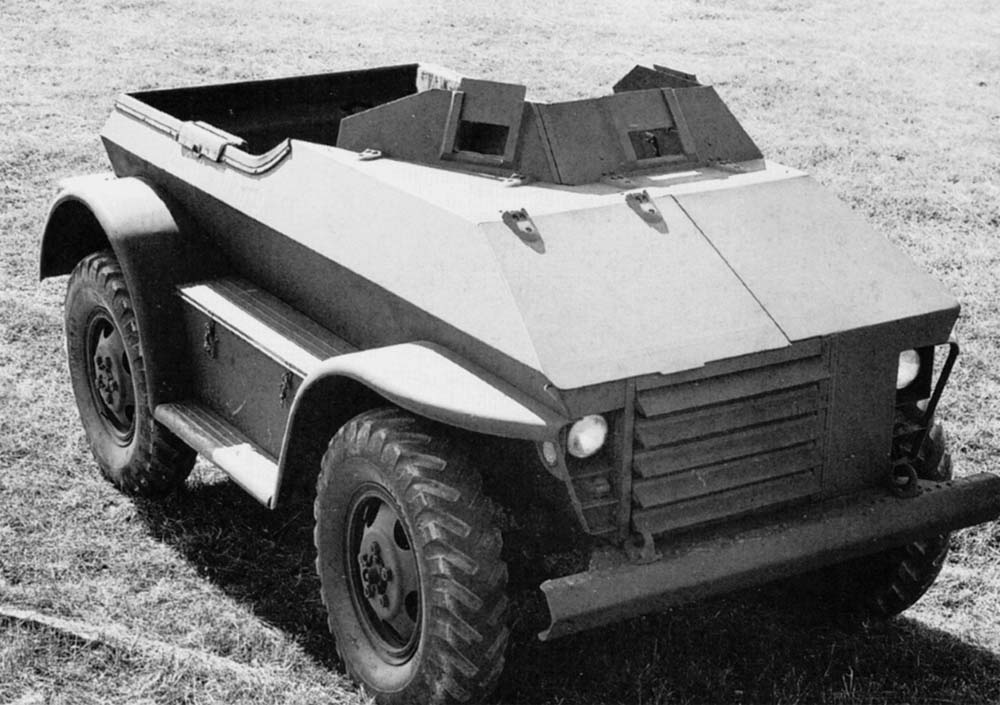
The T2 Observation Post Tender weighed 5,800lbs empty and was intended to be manned by a crew of three. Power for the vehicle came from a 90hp engine, which provided it a maximum speed on level roads of 55mph. The front of the vehicle was protected by armour 0.375-inch thick and the side by armour 0.25-inch thick. It failed to impress the US Army and was never placed into series production. (TACOM)
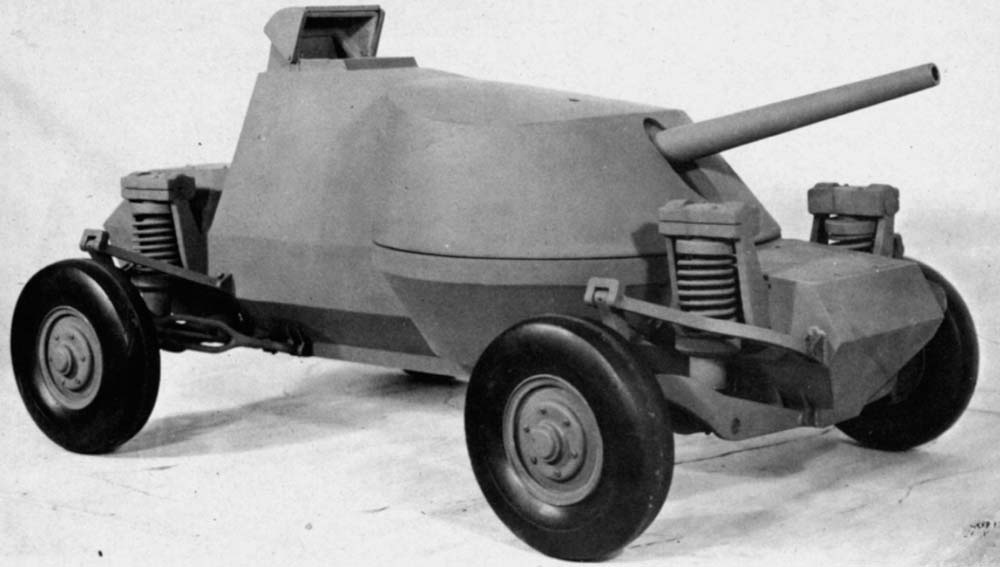
The more fanciful wheeled AFV proposed to the pre-Pearl Harbor US Army was referred to as the ‘Baker jumping vehicle’. It was to come in either an eight-wheel or four-wheel version. It was thought that its suspension system would allow it to hurl itself over obstacles of a certain size. Wiser heads soon prevailed and it never progressed past the wooden model stage, as seen in this picture. (Patton Museum)
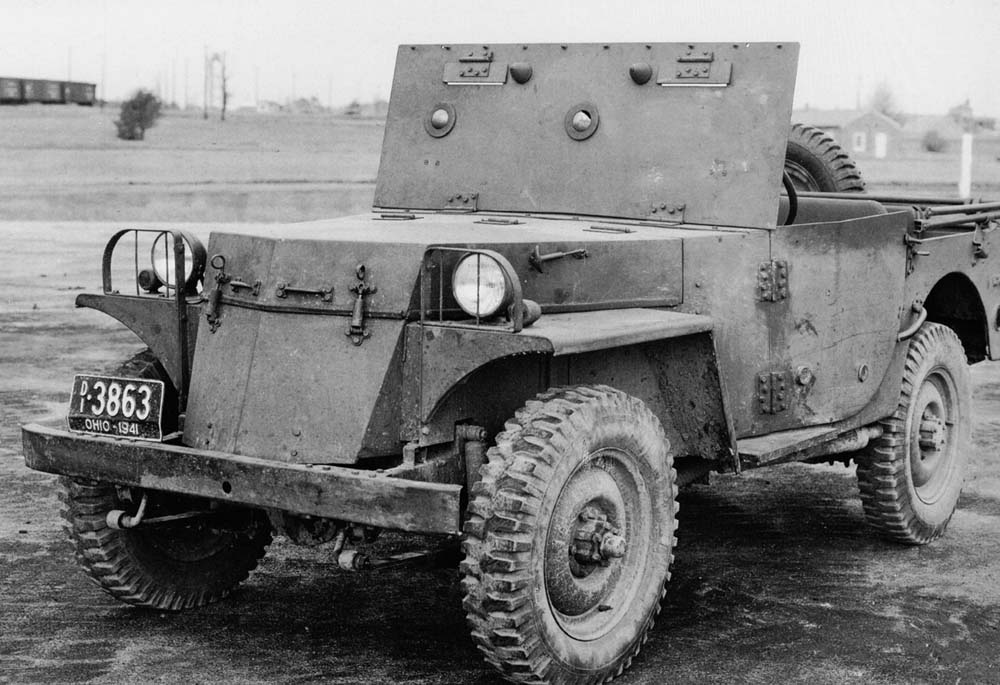
The introduction of the 0.25-ton ‘Jeep’ into US Army service as a reconnaissance vehicle in 1941 prompted the Ordnance Department to test the concept of providing it with a certain degree of armour protection. Pictured is the first test unit labelled as the T25 Scout Car. As is evident in the picture, the armour protection was confined to the front of the vehicle. (TACOM)
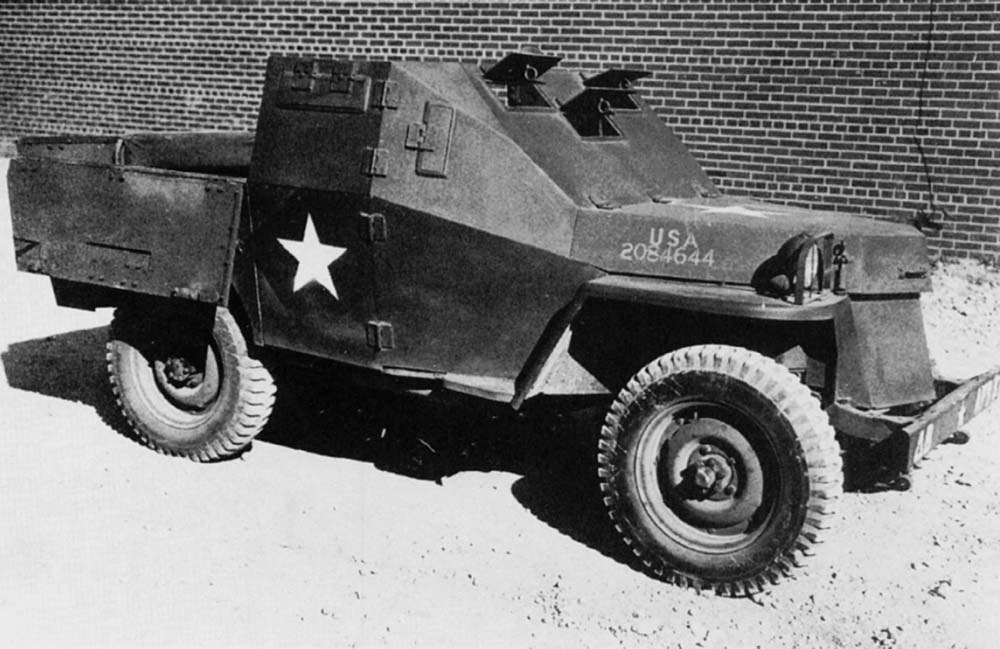
The pre-Pearl Harbor testing of the T25 Scout Car by the Ordnance Department was not positive and it went nowhere. However, wartime requests by the user community pushed the Ordnance Department to revisit the concept of an armoured jeep. This would result in the T25E1 Scout Car, the T25E2 Scout Car (pictured), and the T25E3 Scout Car. As before, the concept was not practical and the programme was eventually cancelled. (TACOM)
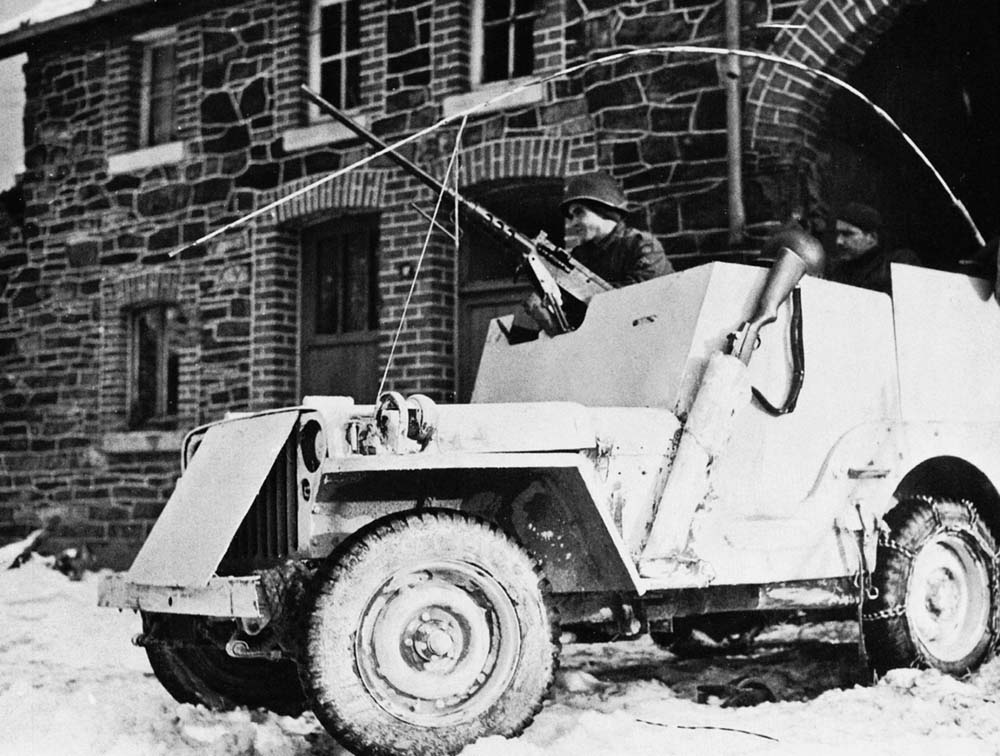
The cancellation of the T25 series Scout Cars did not deter those soldiers in the combat zones of operations from going ahead and developing their own improvised armour kits. Pictured is an example of one of those home-made armoured jeeps of the 82nd Airborne Division operating near La Gleize, Belgium, on 18 January 1945. (Patton Museum)
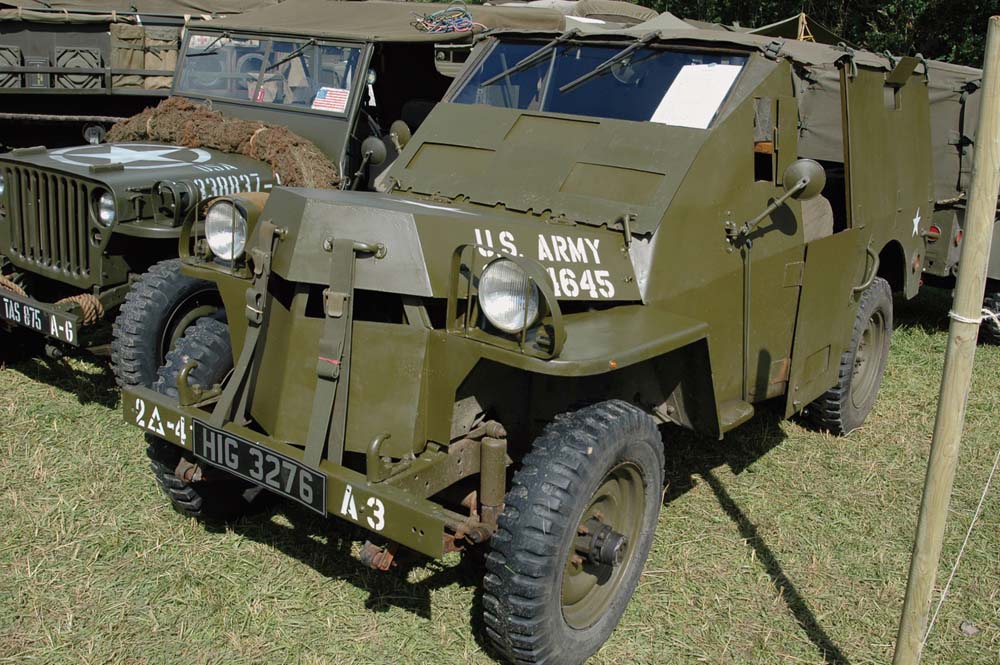
In this picture we see a restored wartime US Army Jeep at a military vehicle collectors’ meet. The owner has fitted it out as a copy of one of the many improvised armour kits added to Jeeps in Western Europe by US Army soldiers during the last two years of the Second World War. (Christophe Vallier)
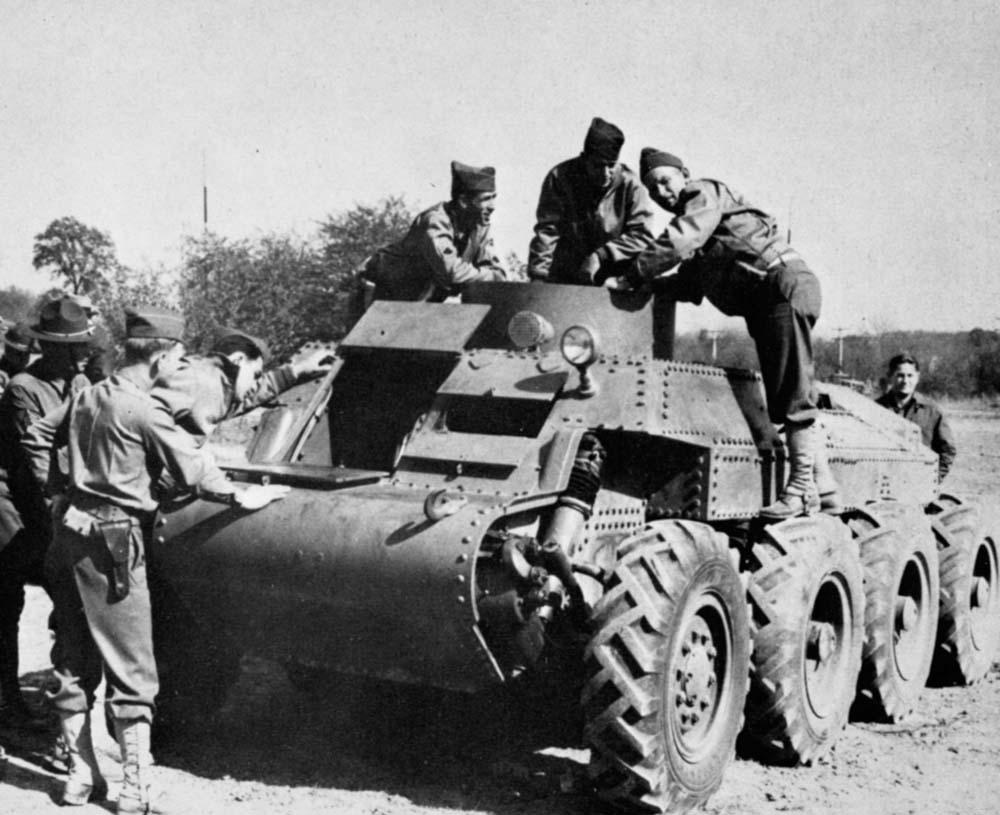
In early 1941, an eight-wheeled vehicle fitted with a state-of-the-art independent suspension system was tested by the Ordnance Department, which labelled it as the T13 Armored Car. The firm that designed the vehicle was named the Trackless Tank Corporation and originally marketed it as a possible replacement for fully-tracked AFVs. (TACOM)
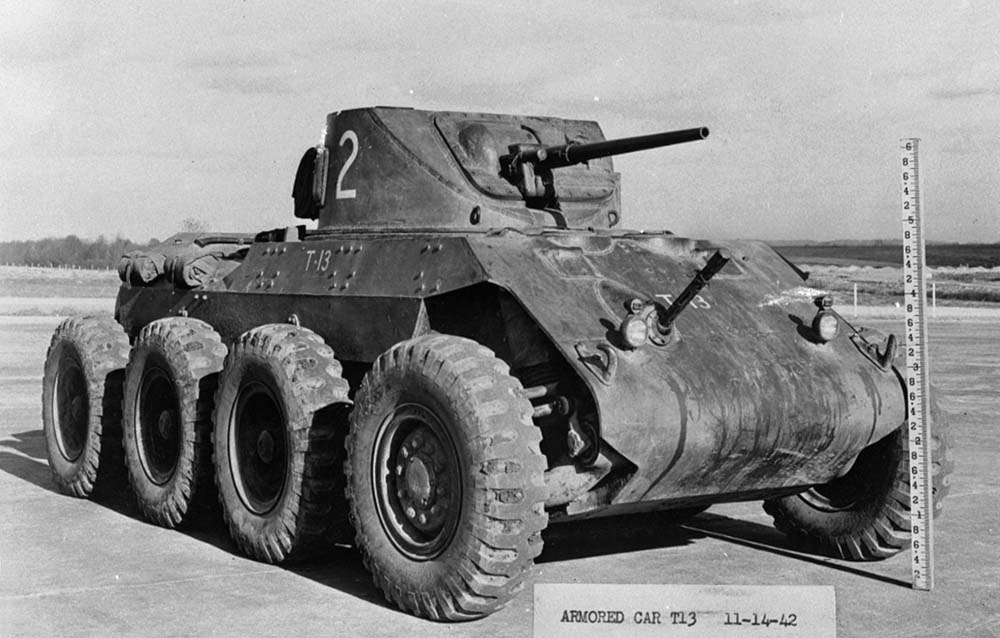
With America’s official entry into the Second World War in December 1941, the Ordnance Department had the chassis of the T13 Armored Car lengthened and equipped with larger wheels. It was also fitted with an open-topped turret armed with a 37mm main gun and two small-calibre machine guns, as seen in this picture, and relabelled as the Armored Car T13. (TACOM)
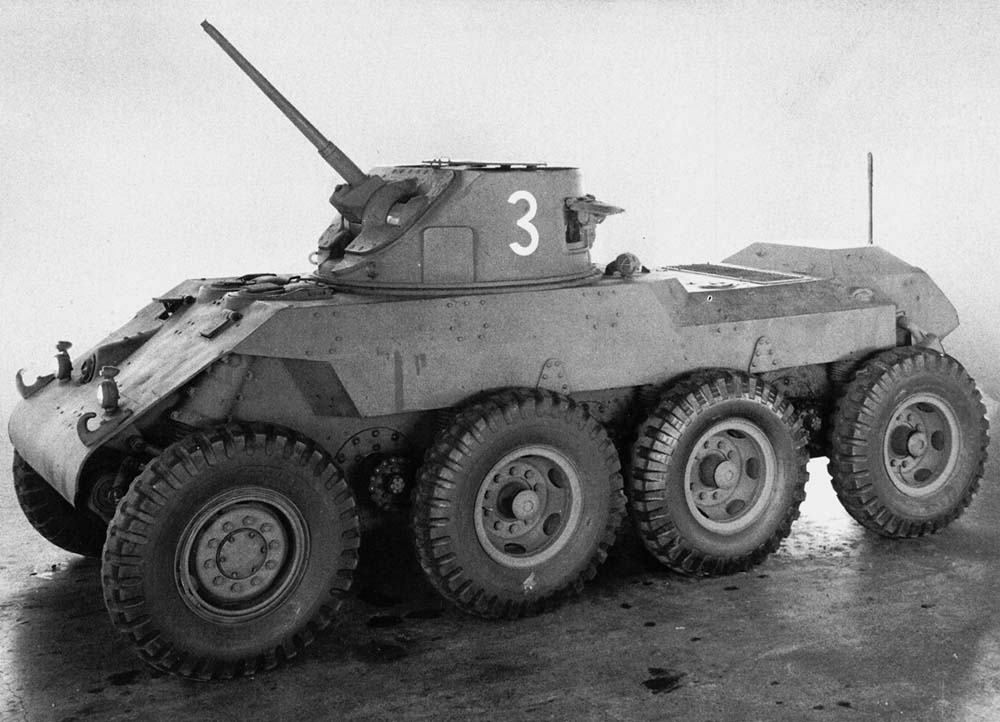
The Ordnance Department’s early testing of the T13 Armored Car was not positive. Although the manufacturer submitted an improved version of the vehicle which addressed the design flaws uncovered in the initial testing, the Ordnance Department had already made up its mind and the T13 Armored Car programme, as well as related vehicles based on its chassis, were all cancelled. (TACOM)